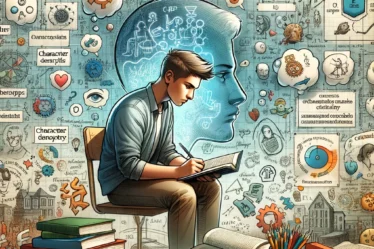
Language functions as a complex tool, entwining thoughts, emotions, and narratives to craft the nuanced realm of human expression. Within this linguistic landscape, the distinction between state and dynamic verbs assumes a pivotal role, influencing our capacity to communicate emotions, actions, and experiences. In this blogpost we’ll dive into the grammatical compositions of state and dynamic verbs. So let’s get started!
Chapter 1: Understanding State and Dynamic Verbs
Defining State Verbs:
Language possesses the remarkable ability to paint vivid portraits of emotions and enduring states. State verbs, such as “like,” “love,” “hate,” “admire,” and “feel,” act as powerful descriptors conveying unchanging conditions and sentiments. For instance, when someone says “I adore the tranquility of the ocean,” the verb “adore” reflects a deep-seated emotion that remains constant. These verbs lay the foundation for us to express our perceptions and affections without the constraint of time.
Example 1: “She loves the aroma of freshly baked bread.” The state verb “loves” conveys her perpetual fondness for the aroma, an emotion that endures over time.
Example 2: “Mark believes in the power of positive thinking.” The state verb “believes” encapsulates Mark’s unwavering conviction, a belief that remains steadfast.
Exploring Dynamic Verbs:
Dynamic verbs infuse language with motion, action, and change. Unlike their static counterparts, these verbs, like “see,” “have,” “eat,” and “run,” propel sentences forward, enveloping actions within their narrative. Imagine “She sees the world through a different lens,” where the verb “sees” animates the act of observation. Dynamic verbs are the engines of stories, propelling characters across landscapes and circumstances, painting scenes that unfold over time.
Example 1: “John runs along the trail every morning.” The dynamic verb “runs” signifies John’s regular physical activity, imbuing the sentence with action and energy.
Example 2: “They are having a picnic by the river.” The dynamic verb phrase “are having” emphasizes the ongoing nature of the picnic experience.
Chapter 2: Verbs and Tenses
State Verbs and Simple Tenses:
The dynamic interplay between state verbs and simple tenses unveils a rich tapestry of expression. Present simple, past simple, and future simple tenses provide the canvas on which the unchanging hues of state verbs are painted. “She likes classical music” showcases the present simple tense in harmony with the state verb “likes.” This tense-category union becomes a portrait that captures a perpetual sentiment, allowing us to navigate through emotional landscapes without temporal boundaries.
Example 1: “He has a deep appreciation for art.” The present simple tense, paired with the state verb “has,” conveys his ongoing appreciation as a constant aspect of his character.
Example 2: “She will always cherish her childhood memories.” The future simple tense combined with the state verb “will always cherish” encapsulates the enduring nature of her sentiment.
Dynamic Verbs and Continuous Tenses:
Conversely, dynamic verbs flourish within the realm of continuous tenses – present continuous, past continuous, and future continuous. These tenses thrust us into the heart of action and progression. “He is running toward victory” employs the present continuous tense to encapsulate an ongoing event. These tenses don’t merely recount actions; they immerse us in the unfolding narrative, placing us amidst the vibrancy of experiences.
Example 1: “They are exploring the ancient ruins in Greece.” The present continuous tense emphasizes their current and ongoing exploration of the ruins.
Example 2: “While I was walking in the park, I saw a shooting star.” The past continuous tense “was walking” in conjunction with the dynamic verb “saw” conveys a specific action within a continuous context.
Chapter 3: Nuances and Contexts
Overlapping Cases:
In the fluid expanse of language, verbs often transcend their designated categories, existing as chameleons that adapt to context. The verb “see,” for instance, dances between states and dynamics. In “I see the beauty in simplicity,” “see” manifests as a state verb, reflecting an enduring perception. Contrastingly, in “I am seeing my friend this weekend,” it transforms into a dynamic verb, embodying an impending action. Such linguistic versatility allows us to capture a spectrum of experiences with precision.
Example 1: “She sees the potential in every challenge.” Here, “sees” operates as a state verb, portraying her consistent perception of potential.
Example 2: “I am seeing the doctor tomorrow.” In this case, “am seeing” shifts “see” into the realm of dynamic verbs, indicating a scheduled action.
Modals and Their Impact:
Modals – those auxiliary verbs like “can,” “could,” and “may” – introduce an additional layer of complexity to the dance of state and dynamic verbs. They alter the narrative tone and emotional resonance. For instance, “She can see the hidden truth” marries the modal “can” with the dynamic verb “see,” forming a potent combination. Modals imbue verbs with potential, casting them in shades that resonate beyond their literal meanings.
Example 1: “He can feel the tension in the room.” The modal “can” coupled with the state verb “feel” amplifies his ability to perceive nuances.
Example 2: “They could taste the spices in the dish.” The modal “could” combined with the dynamic verb “taste” enriches the experience of tasting spices.
Chapter 4: Application in Communication and Writing
State and Dynamic Verbs in Conversational English:
Language, as a vehicle for connection, thrives on the interplay between state and dynamic verbs. In everyday conversations, these verbs shape our interactions, coloring our expressions with shades of emotions and actions. When we say, “I appreciate your help,” the state verb “appreciate” infuses gratitude into the conversation. Conversely, “She is describing her travel adventures” employs the dynamic verb “is describing” to engage listeners in the unfolding narrative. The choice between state and dynamic verbs navigates the conversational currents, sculpting the flow of ideas and sentiments.
Example 1: “He adores sunsets like paintings.” The state verb “adores” conveys his unwavering love for sunsets, likening them to works of art.
Example 2: “They are sharing their thoughts on the new book.” The dynamic verb “are sharing” animates the act of sharing thoughts, creating an interactive dialogue.
Crafting Writing Styles with Verbs:
In the realm of writing, verbs operate as brushes on the canvas of imagination. State and dynamic verbs collaboratively shape the landscapes of narratives, essays, and descriptive passages. “The old oak tree stands as a sentinel of time” utilizes the state verb “stands” to evoke the enduring presence of the tree. Meanwhile, “The protagonist raced against time” employs the dynamic verb “raced” to inject urgency into the narrative, propelling readers through the story’s twists and turns.
Example 1: “Her laughter echoes through the room.” The state verb “echoes” resonates with the lasting impact of her laughter in the environment.
Example 2: “He was swimming against the current.” The past continuous tense with the dynamic verb “was swimming” captures a snapshot of an ongoing action in the past.
Chapter 5: Expanding Horizons: Language Evolution and Learning
The Evolution of Verbs in Language:
Language is a living entity that evolves alongside human experiences. State and dynamic verbs, like linguistic time capsules, embody the spirit of their eras. The meaning of certain verbs shifts over time, reflecting cultural shifts and new perspectives. For example, the verb “tweet” transitioned from representing a bird’s call to describing a digital message. This evolution invites us to glimpse the journey of words through history, connecting past and present in a shared linguistic tapestry.
If you’re interested in learning more about how the English language had developed over time, go to this blogpost on: The History and Evolution of English Language.
Example 1: The verb “broadcast” initially referred to the transmission of radio signals but has evolved to encompass various forms of communication.
Example 2: “Text” transformed from being a noun for written material to a verb describing the act of sending short messages electronically.
Enhancing Language Learning: Interactive Exercises:
Engaging with the intricacies of language involves not only understanding but also practical application. Here’s an interactive exercise to reinforce your grasp of state and dynamic verbs:
Exercise: Identify whether the verbs in the following sentences are state or dynamic verbs, and explain your choice.
- ”She adores spending time in nature.”
- ”The river flows gently through the valley.”
- ”I can feel the warmth of the sun on my skin.”
- ”They are building a new bridge across the river.”
Chapter 6: Personalized Tutoring: Navigating the Verb Landscape
The Role of Tutoring in Language Learning:
As our exploration deepens, we unveil the role of personalized tutoring in the realm of language mastery. Tutors serve as navigational guides through the verb landscape, offering tailored guidance that complements self-study and traditional education. Just as we’ve navigated through the nuances of state and dynamic verbs, tutors walk alongside learners, adapting their approach to address specific needs.
To learn more about how a tutor can help you improve your English language, have a look at this blogpost on “the benefits of one-on-one English tutoring”.Tailoring Verb Exploration Through Tutoring:
Personalized tutoring creates a platform for learners to explore state and dynamic verbs in alignment with their goals. Tutors recognize that no two learners are alike – they tailor lessons to match individual aspirations, pace, and strengths. Whether you aim to convey emotions eloquently using state verbs or narrate actions vividly through dynamic verbs, tutoring offers a customized pathway to achieving linguistic finesse.
If you’re interested in learning about some of the most common English grammar mistakes, click here to find a comprehensive blogpost on: common grammar mistakes and how to avoid them.
If you prefer face-to-face interactions, consider seeking out a local tutor in your vicinity. Search terms like English tutor Liverpool or English teacher Manchester can help you uncover options that provide structured courses designed to match your skill level.
Or, for instance, if you reside in London and are interested in finding a language school, a straightforward search for “language school London” can yield relevant results tailored to your goals. Similarly, if you’re located in Manchester, exploring “English language class Manchester” can connect you with institutions offering immersive educational experiences.
Conclusion: Embracing the Complexity of Expression
In our exploration of state and dynamic verbs, we’ve seen how words can paint emotions and actions vividly. From steady descriptions to active narratives, these verbs shape our language. Beyond rules, personalized tutoring boosts confidence in speaking and expressing ourselves. So, as we wrap up, let’s remember that our choice of verbs can bridge connections and give life to our words, making communication a powerful tool in our hands.
Finally, if you’re looking to dive further into English grammar rules, you can check out these two blogposts on: Present Perfect Tense and Relative Clauses.
Good luck and happy learning!


